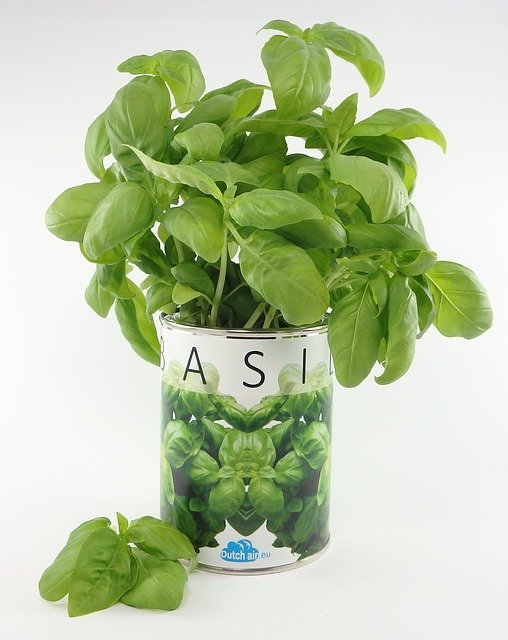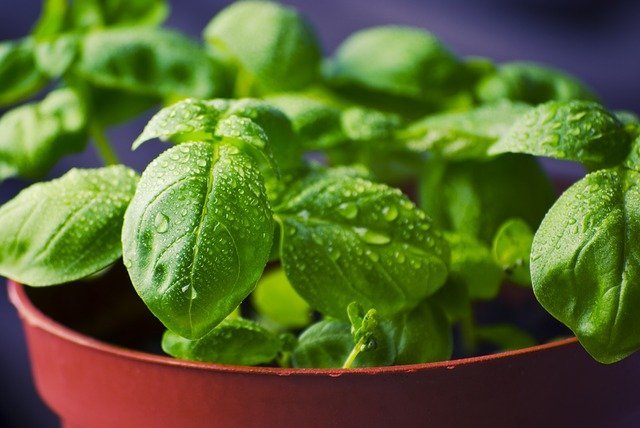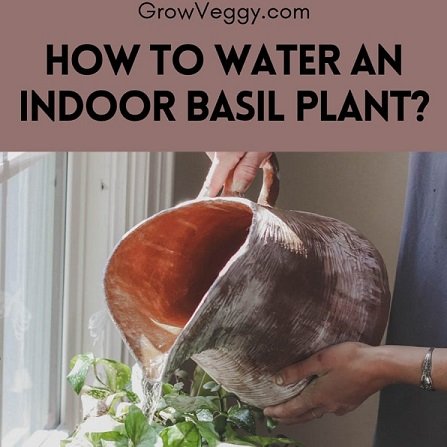While Basil is easy enough to grow, watering it can be a bit challenging as basil has very specific water requirements.
The key to watering the basil is to water it when it requires or when the soil is dry. This may depend on factors like season, soil, or the container that you have grown.
Basil is an annual herb that thrives in moist soil, but it cannot live in soggy soil. Thus it is important to keep the basil watered whenever the soil gets dry, but not so much that the soil becomes waterlogged.
Belonging to the mint family, it is a bushy herb that doesn’t have a woody structure that can support itself. It, therefore, needs a constant supply of moisture in the soil as well as transpiration so that the basil stems do not wilt or droop.
It is therefore important to keep the soil moist at all times.
Factors that impact the frequency of watering Basil
How often to water depend on a lot of factors such as where, when, and how you are growing it.
1) Where you have grown Basil?
Basils grown in containers and indoors will need to be watered more often than the ones grown outside directly in the ground.
Usually, basil grown in containers and pots can be watered every 3-4 days in high temperatures or no rainfall.
A larger pot can contain more soil and therefore can retain more water and moisture. So, it is preferable to have a large pot, at least 12 inches wide for adult basil. A small pot can dry out quickly as it cannot hold much water.
The material of the pot also matters in planting basil. A metal pot will absorb more sun, making evaporation faster. This will lead to the plant requiring water often.
A pot made of clay or terracotta or ceramic can hold in the water better than plastic or metal.
2) When you are Watering?
The season and climate will also determine the amount of water that the basil will need.
If you live in a warm or hot region and grow your basil in a container, you are going to have to water it once or twice a day in summer.
In cool weather with rainfall, it should be watered once a week by checking the soil.
3) How do you plant the basil?
The soil, container, and fertilizers also play a very important role in deciding how often you need to water your basil.
Different soil types will hold different amounts of water, which is why the type of soil you use will influence the amount of water your plant will require.
Basil cannot grow in clay soil. Clay soil is too heavy and will easily suffocate the roots.
Growing basil in the sand is also not a good idea. While it is possible, it will require an excessive amount of water and a lot of attention.
A potting mix with a high amount of peat moss, compost, or coco coir will require a lot less water as they trap a lot of water.
Why does basil smell different? Like Licorice, cinnamon, lemon, cat urine

When you should water your basil?
There are two important things that will tell you when to water your basil, irrespective of all the other factors that are necessary to create a watering schedule.
a) When the plant asks for it
Basil can be called an expressive plant. That is, you will know when the plant needs water if you observe closely.
Basil requires moist soil which is well-drained, not water-logged.
When the basil does not get the water that it requires, in a few hours the plant will start bending and the leaves will look droopy.
When this happens, the plant is still fine, but it is time to water it because this is how the basil communicates its need for water.
Once you water it sufficiently, the plant will get back to normal within 2 hours.
Once you get to know this pattern, you won’t have to wait for your basil to wilt anymore. You will learn its requirements and can water it accordingly.
It is important to know, however, that this time period will change along with the seasons. So it is necessary to take the seasons and climate into consideration and adapt your watering schedule accordingly.
b) When the deep soil is dry
Another thing to take into account is the dryness of deep soil.
As we know, basil requires moist soil. Sometimes, the top layer of the soil may look and feel dry, and we think that it is time to water the basil.
But that may not be true. The superficial soil can become dry easily, especially in hot months. However, the basil takes in water from the deeper soil and that is the soil you need to check.
Simply stick your finger 1 to 2 inches inside the soil. If the soil feels wet and sticky, the basil is all right and does not need water. If the soil feels dry and crumbly even on the inside, then it is time to water the plant.
This can also happen the other way around. Sometimes the soil on the top is wet, but the soil inside is dry and needs to be watered. Therefore, it is necessary to stick your finger in the soil every now and then to check whether your plant needs water.

How much water is enough for growing Basil indoors?
The amount of water required for basil has been a debatable topic. With its very specific watering needs, watering a basil plant can be a bit of a hassle.
Basil needs moist, well-drained soil. Watering a basil plant growing indoors is much more difficult than a garden plant because the means of evaporation and drainage are fewer.
The most important thing for an indoor basil plant is to have a container that has good drainage holes.
The basil should be watered until right before the first drops of water start leaking out from the drainage holes of the planter. This is because the soil absorbs water like a sponge.
Once it reaches its saturation point, it cannot absorb any more water and that leads to the water leaking out.
If the planter does not have a drainage source, the water will have no scope of flowing out and the plant will become waterlogged and start rotting.
Watering Basil at the seedling stage
At the seedling stage, the plants should be misted every other day. Basil requires consistently damp soil at the seedling stage. They cannot handle deep watering like full-grown basils.
As the plant germinates, spray water on the soil using a sprayer or a mister to keep the top layer moist but not soggy.
Watering a full-grown Basil
A basil plant should be watered daily only when it is grown outdoors. An indoor plant should be watered as the soil dries.
While watering, take care to never water from overhead. Water the soil, not the leaves. The best time to water your basil is in the morning as the least amount of evaporation happens at this time.
Basil Overwatering
Overwatering is one of the most common mistakes, especially among beginners.
We have always learned that we should water our plants every day, and not wanting our plants to lack water, we religiously follow that advice.
But for a lot of plants, providing water every day leads to overwatering. Watering basil is a task that takes time to learn, and it can be difficult if you are new to it.
In an outside garden, the water evaporates quicker, but indoors, the water stays accumulated in the soil for a longer time.
Basil needs moisture consistently, but it cannot grow well in soggy soil. When planted in well-drained soil, there is enough space for air to circulate through the roots.
Roots need air to work. When the soil is waterlogged, there is no space for air to move freely which can suffocate the roots and cause problems.
Aside from too much water, Overwatering can be caused by
- pots that do not have drainage holes
- using the wrong soil
- picking the wrong size of container with respect to the size of the plant
- not checking the soil before watering
Symptoms of Basil Overwatering
Plants will communicate when things are wrong. Basil, being an expressive plant, will also do so as soon as something goes wrong.
- Overwatered basil will show signs of wilting even though the soil is wet.
- The leaves might become yellow or brown, starting from the bottom, and dropping off. Read more about black leave on basil leaves here.
- The stems darken.
- Blisters or bumps may appear on the leaves in a condition called edema, which occurs when a plant takes up more moisture than required.
- There might be an algae growth on the top of the soil, with a greenish tinge.
- The growth of the plant could be stunted.
- There are chances of bad odor coming from the soil.
- Inspecting the roots will also tell you if your basil is overwatered. If a large part of the roots is black or brown and soft, it means the roots have rotted.
Fungal diseases and rotting of the roots are the main effects of overwatering.
How to fix overwatered basil?
Fixing overwatered basil depends on how often it has been overwatered.
It is easy to fix plants that have been overwatered once or twice, but an excessively overwatered plant might require elaborate treatments.
- The first thing to do is to stop any water flow to the plant. An overwatered plant needs to dry off first. If it is raining, cover the plant with a plastic sheet or tarp until it dries.
- Pick off the leaves that have turned yellow or brown. They are redundant and will waste the plant’s energy. If entire sections of the plant have turned yellow or brown, prune the whole section so that the plant can put its energy into building up better roots.
- Remove the mulch around the plant to help the plant dry off quicker. The mulch helps in keeping the plant moist. Save it for later when the plant resumes its original watering.
- Let the soil dry out. The top two inches should be dry while the bottom layers should be moist but not soggy. The time it takes for the soil to dry will depend on the climate.
- To help the soil dry faster and let some air in, poke some holes around the plant in the soil. The air will be able to reach the roots and help them to dry out faster.
- Lastly, if the root damage is minimal, it is possible to save your basil by transferring it into another pot. The new pot should contain dry, well-drained soil.
Why are there ants on my basil plant and how you can get rid of them?
Basil Underwatering
When the soil becomes too dry, it means that you are underwatering the plant.
Because watering a basil plant is a bit different and it is advised not to water it every day, a lot of people don’t water it for long periods of time.
Not watering every day is okay in monsoons or winter seasons, but if your plant sits on a windowsill in hot summers, it will obviously require more water, and underwatering the plant will kill it.
Symptoms of Basil underwatering
An underwatered basil will have leaves that look dull and pale. When the need for water increases, the leaves become dry and brittle.
Underwatered basil will also show signs of wilting. The leaves will turn yellow starting from the bottom and they will start shrinking.
It is also possible that the topsoil looks moist, but the rest of it is dry. So, it is important to check 1 or 2 inches underneath.
How to fix underwatered basil?
If the damage is minimal, the plant can be saved by watering quickly.
Water the plant thoroughly. Keep it bright in indirect light and water it whenever the soil feels dry to the touch. Once the plant has come back to normal, you can resume your normal routine.


